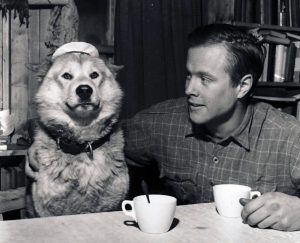Did you know that dogs are banned from Antarctica?
But it used to be common practice to bring dogs along to Antarctica. Dogs served as draught animals and helped with transport of supplies and equipment.
 Dogs have been used for both business and pleasure during long expeditions in the icy Antarctic waste. This is from the Norwegian Antarctic expedition of 1949-1952 (the Maudheim expedition). Photo: Norwegian Polar Institute
Dogs have been used for both business and pleasure during long expeditions in the icy Antarctic waste. This is from the Norwegian Antarctic expedition of 1949-1952 (the Maudheim expedition). Photo: Norwegian Polar Institute
As early as in 1898-1900, the Norwegian polar explorer Carsten Borchgrevink took 90 dogs to Antarctica. The expedition’s financial backing was from England, but most of the crew and the researchers were Norwegian. Two Sami men, Ole Must and Per Savio, had been included to care for the dogs. The dogs made it possible to get around efficiently on the icy continent. The expedition members made several short excursions by dogsled to the eastern side of Kapp Adare, and a few trips to more distant areas to do surveying.
When Roald Amundsen conquered the South Pole in 1911, his success was largely based on quick and efficient transport by dogsled to the geographical pole (“Polheim”). He brought along approximately 98 dogs to Antarctica, mainly dogs purchased in Greenland. In preparation for the actual attempt to reach the pole, depots containing food and equipment had been established. These depots were marked with dried fish so the dogs would catch the scent from afar and be guided straight to the depots. On the way to the South Pole, most of the dogs were slaughtered and used as food for both dogs and humans. The site of the slaughter was given the name “Slakteren” (the Butcher). Roald Amundsen’s lead dog was named Obersten (the Colonel) and was one of the eleven dogs that returned from the South Pole and sailed with Fram to Argentina. There, the rest of the dogs died of illnesses or were sold. Only the Colonel returned to Norway alive.
Later expeditions have also used dogs, even after tracked vehicles came into use. Dogs were dependable, and they were important for the well-being of many expedition members, who enjoyed playing and talking with “their” dogs. The Norwegian Antarctic expedition of 1956-1960 took along 42 Greenland huskies. The dogs reproduced during the three years the expedition lasted, and several litters of puppies were born. As it turned out, the dogs that came from Greenland were unable to adapt to the seasons in Antarctica: they continued to follow the seasonal patterns of their home in the northern hemisphere. The dogs that were born in Antarctica, on the other hand, shed their fur at the right time.
Norway ratified the Protocol on Environmental Protection of Antarctica and it became binding as of May 1995. The Protocol’s paragraph 15 states that dogs may not be introduced because of the risk that they might bring along infections.